Do you dream of a peaceful spot in your backyard? Imagine turning your outdoor area into a Zen garden. It could feel like a calm Japanese landscape. But how do you make it your own without losing your style? Let’s explore beautiful Zen garden ideas to create your own backyard sanctuary.

Key Takeaways
- Explore the philosophy and key elements of traditional Japanese Zen gardens
- Learn how to balance the essential design components for a harmonious outdoor retreat
- Discover inspiring ideas for incorporating water features, gravel arrangements, and strategic plant selection
- Create comfortable meditation and seating areas to enhance your Zen experience
- Optimize your garden’s lighting to set the perfect mood for relaxation and reflection
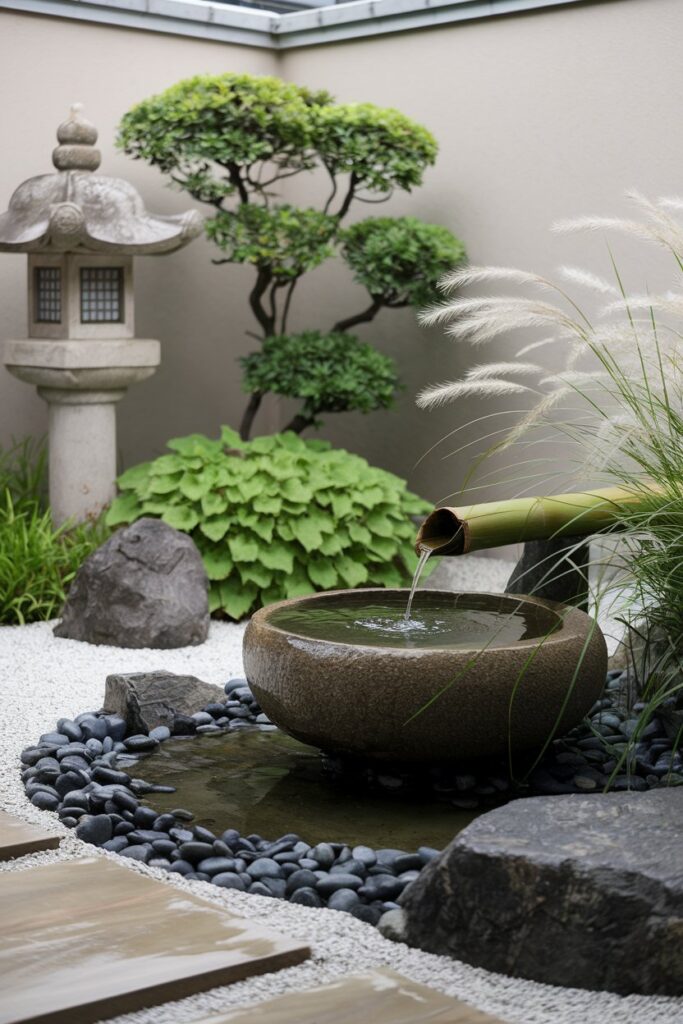
Understanding the Essence of Zen Garden Design
Making a Zen garden is more than just picking pretty things for your yard. It’s a deep philosophy based on Japanese garden beauty. It values simplicity, balance, and blending with nature.
The Philosophy Behind Japanese Garden Aesthetics
Zen gardens, or “dry landscapes,” follow the ideas of wabi-sabi and shibui. These are about loving the imperfect, fleeting, and subtle beauty. They show the beauty of nature, helping us connect with it more deeply.
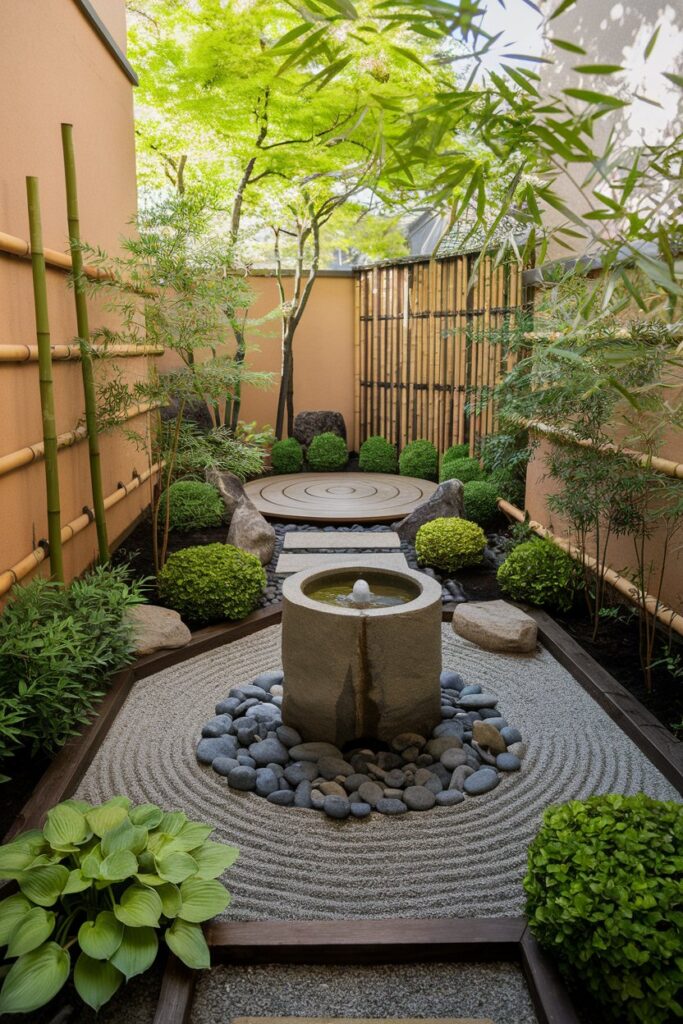
Key Elements of Traditional Zen Gardens
- Rocks and gravel: They stand for the earth and mountains, making a simple yet powerful view.
- Carefully placed plants: These are often evergreen, mosses, and small plants. They add to the natural look without taking over.
- Water features: Sounds of water from streams, ponds, or stones bring calm.
- Bridges and pathways: They help us walk through the garden, guiding our thoughts.
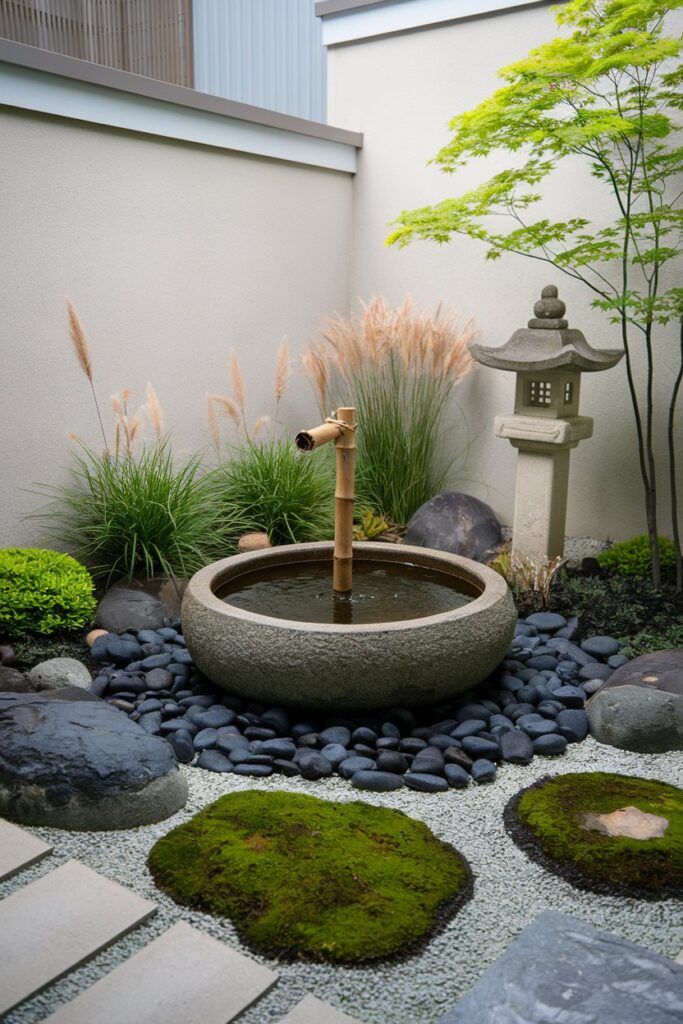
Balancing Elements in Your Space
The true beauty of Zen garden design is in finding balance. By thinking about where to put rocks, gravel, plants, and water, you can make a peaceful place. This place shows the beauty of Japanese garden philosophy, Zen garden elements, and harmony in design.
“The art of Zen garden design is not about filling a space, but about creating a sense of balance and simplicity that invites contemplation and reflection.”
Essential Components for Creating Your Backyard Zen Sanctuary
Creating a Zen garden in your backyard is a rewarding DIY project. It can turn your outdoor space into a peaceful oasis. You’ll need to choose the right Zen garden materials to capture the Japanese design’s essence. Each element, from rocks and gravel to plants, is crucial for a calming atmosphere in your DIY Zen garden.
Start with the foundation of your backyard sanctuary. Use high-quality rocks and gravel that match your surroundings. Arrange them in patterns that look good and reflect the natural beauty. Adding a water feature, like a small pond or stream, will enhance the Zen feel with its soothing sounds.
Then, pick plants that do well in your area. Japanese maples, bamboo, and evergreens are great choices for their minimalist beauty. Place these plants to create balance and peace, making them a key part of your sanctuary.
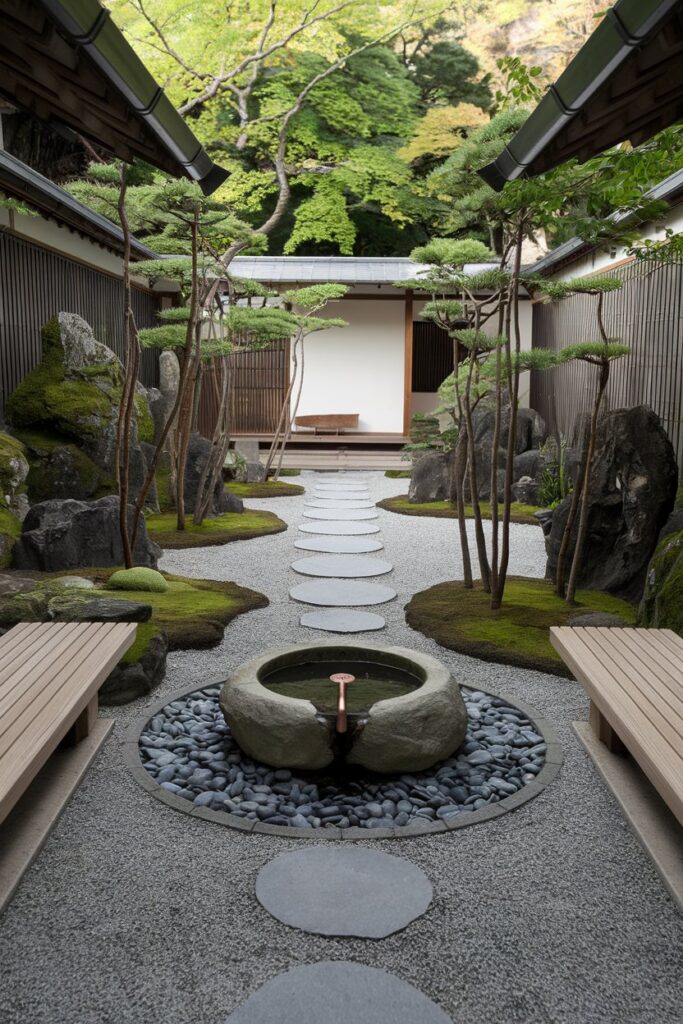
| Essential Zen Garden Materials | Characteristics |
|---|---|
| Rocks and Gravel | Carefully selected stones and gravel in earthy tones to create the foundation of the garden |
| Water Features | Serene elements like ponds, streams, or fountains to enhance the tranquil ambiance |
| Japanese-Inspired Plants | Thoughtfully chosen greenery, such as Japanese maples, bamboo, and evergreens, to complement the Zen aesthetic |
| Decorative Elements | Carefully placed lanterns, pagodas, or other traditional Japanese-style accents to reinforce the Zen theme |
By selecting these key Zen garden materials, you can make your backyard a serene DIY Zen garden. It becomes a true backyard sanctuary that calms the senses and soothes the soul.
Rock and Gravel Arrangements: The Foundation of Zen Design
A Zen garden’s beauty comes from its rocks and gravel. These elements bring peace and follow Japanese garden rules. Choosing and placing stones can turn your yard into a calm place for thinking and relaxing.
Selecting the Right Stones and Rocks
The stones in your Zen garden mean a lot and help with the look. Pick different shapes, sizes, and textures that go well together. Use boulders, cobbles, pebbles, and special rocks to make your garden interesting.
- Boulders: Show strength and stability, like the garden’s foundation.
- Cobbles: Add texture and can be arranged in cool patterns.
- Pebbles: Make a calm, meditative feel when raked into shapes.
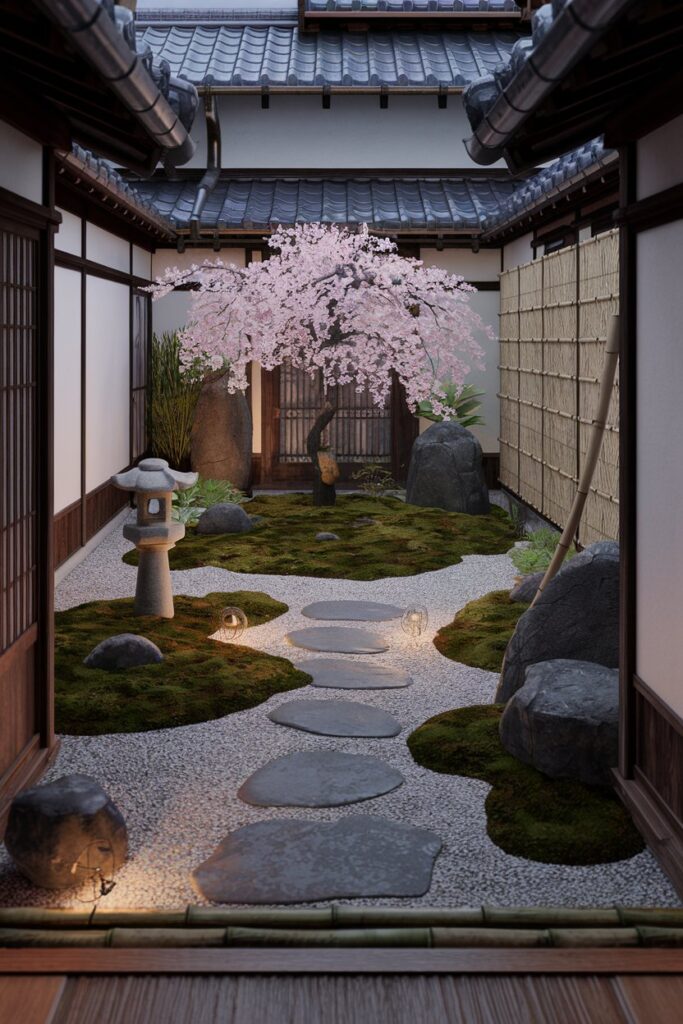
Patterns and Raking Techniques
How you arrange gravel and rocks is key for peace and balance. Try different raking ways to make patterns that look like water or mountains.
Raking gravel is a calming activity. It lets you create your design. Try simple lines or complex shapes to set different moods.
Creating Visual Flow with Gravel
Gravel’s placement can make your Zen garden feel like it’s moving. Use it to guide the eye and make the space feel harmonious.
Make gravel paths for a peaceful walk. Use different sizes and textures to add interest. This makes your Zen garden even more peaceful.
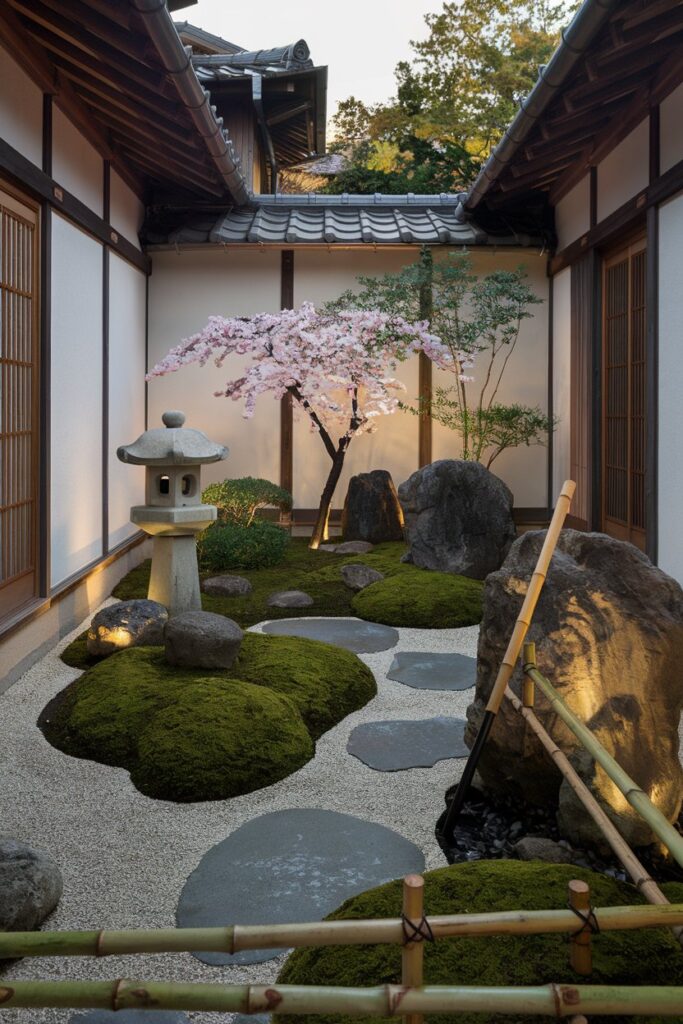
Water Features That Enhance Tranquility
Adding Zen water features to your backyard can make it a peaceful retreat. These features, like garden fountains and water elements, calm the mind and body. They take you to a place of calm.
Small ponds are a favorite for creating tranquility. They reflect the greenery and sky, bringing balance to your view. The sound of water against the pond’s edge is soothing, helping you relax.
Zen garden fountains are also great for adding water to your space. They come in many designs, from simple to fancy. The sound of water from a fountain brings peace and calm.
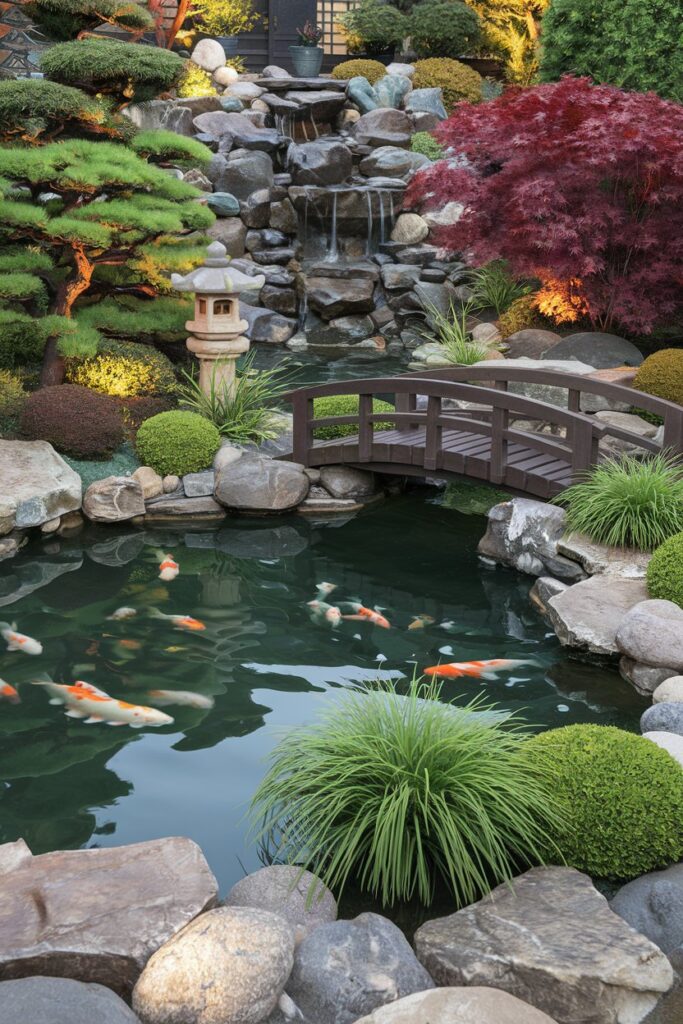
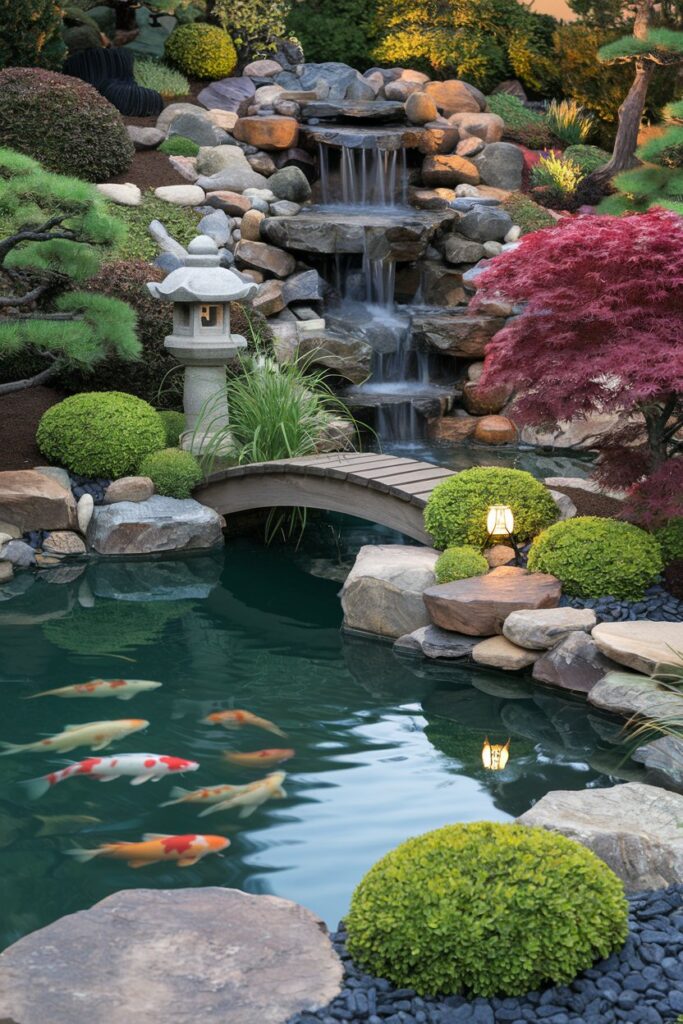
| Zen Water Feature | Key Benefits |
|---|---|
| Pond | Reflective surface creates visual harmony Soothing sound of lapping water Attracts wildlife like koi and dragonflies |
| Fountain | Gentle trickling sound promotes relaxation Diverse design options, from simple to ornate Can be paired with other Zen elements like rocks and greenery |
When picking Zen water features, think about how they fit with your landscape. A well-placed fountain or pond can make your outdoor space more peaceful. It adds to the calm atmosphere.
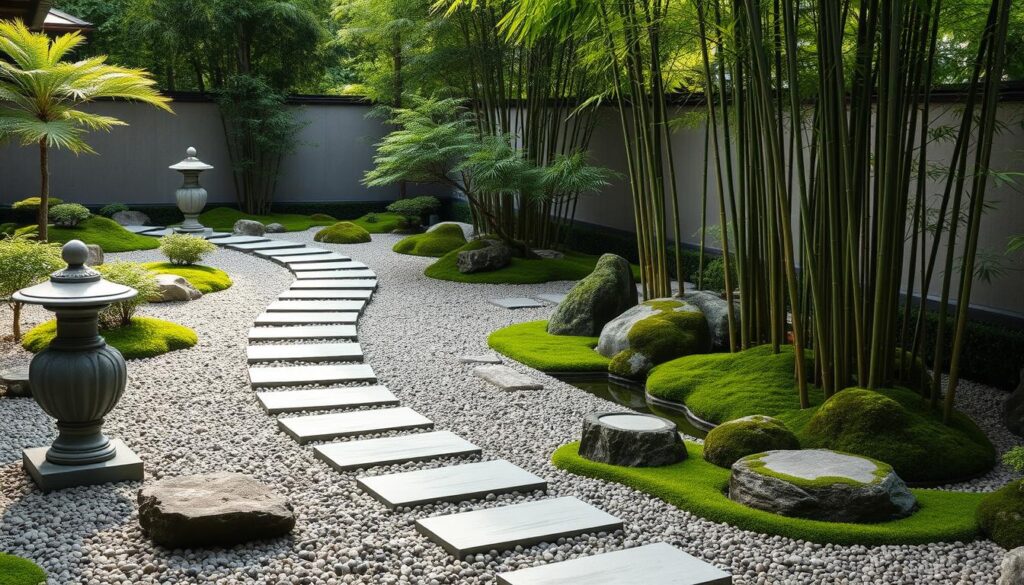
“The sound of water is worth more than all the poets’ words.”
– Minamoto Yoritomo
Outdoor Zen Garden Ideas for Small Spaces
Even with a small outdoor area, you can still create a peaceful Zen garden. Clever design can turn a tiny patio, balcony, or backyard into a calm retreat. Focus on vertical elements and space-saving ideas to make the most of your space.
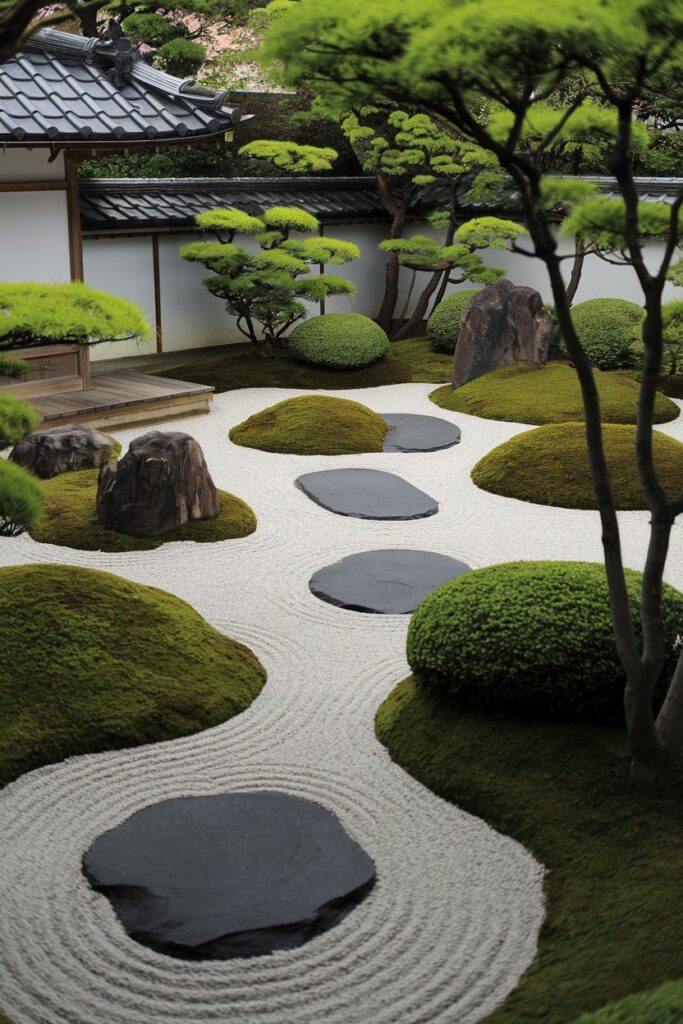
Compact Design Solutions
For a small outdoor space, go for a simple design. Pick a few key elements like a small water feature, rocks, and potted plants. Use wall-mounted planters or a tabletop Zen garden to save space.
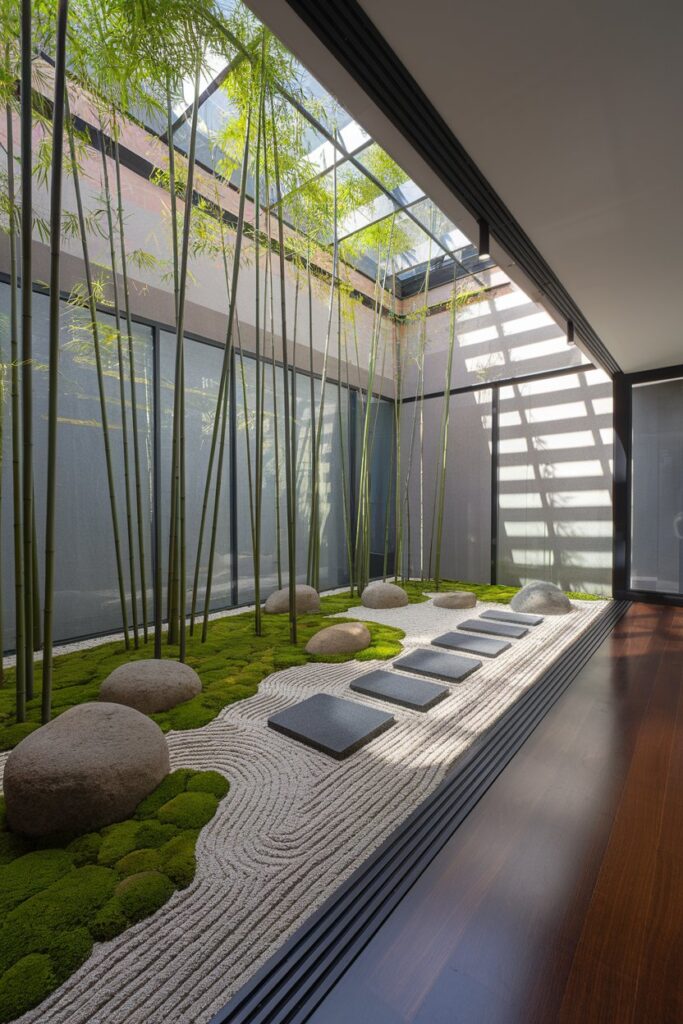
Vertical Garden Integration
Use vertical elements to maximize your space. Hang vines, install a living wall, or use trellises for climbing plants. These features add depth and lushness to your small Zen garden.
Space-Saving Features
- Use furniture that serves multiple purposes, like a bench with storage, to keep things tidy.
- Choose a small, recirculating water fountain that fits on a table or pedestal.
- Go for compact plants like Japanese maples or miniature bamboo that grow well in small spaces.
By applying Zen design principles and creative space-saving ideas, you can turn any small outdoor area into a peaceful Zen garden.
Zen-Inspired Plant Selection and Placement
Designing your backyard Zen garden involves choosing and placing plants carefully. The right Zen garden plants should reflect simplicity, balance, and natural beauty. These are key to Japanese garden aesthetics.
For a minimalist landscaping look, pick plants with simple shapes and soft colors. Some great Japanese garden flora options include:
- Japanese maple (Acer palmatum)
- Dwarf ornamental grasses, such as Mondo grass (Ophiopogon japonicus)
- Azaleas (Rhododendron spp.)
- Moss, which creates a lush, velvety groundcover
- Bonsai trees, which add a touch of miniature artistry
Think about balance and flow when placing your plants. Arrange them to create harmony and visual rhythm. This way, each plant is appreciated on its own while fitting into the overall Zen design.
| Plant | Characteristics | Placement Considerations |
|---|---|---|
| Japanese maple (Acer palmatum) | Delicate, lacy foliage in shades of green, red, or purple | Place in a focal point or as a specimen tree, allowing its graceful shape to be admired |
| Dwarf ornamental grasses | Compact, tufted growth habit with fine, wispy blades | Use as border plants or in mass plantings to create a sense of movement and texture |
| Azaleas (Rhododendron spp.) | Vibrant blooms in shades of pink, purple, or white | Position near seating areas or pathways to enjoy the seasonal floral display |
By choosing and placing your Zen garden plants wisely, you can create a peaceful backyard. It will be a place of tranquility and natural beauty, perfect for finding calm.
Incorporating Meditation Areas and Seating
Creating cozy meditation spots and seating areas is key in your outdoor Zen garden. These spots make your sanctuary even more peaceful. They encourage you to take a break, think deeply, and enjoy the calm atmosphere.
Creating Comfortable Viewing Points
Placing seats in the right spots lets you see your Zen garden’s beauty from different angles. Think about using benches, low stools, or cushions from natural materials like wood, stone, or rattan. These seats can face water features, rock setups, or greenery, helping you relax.
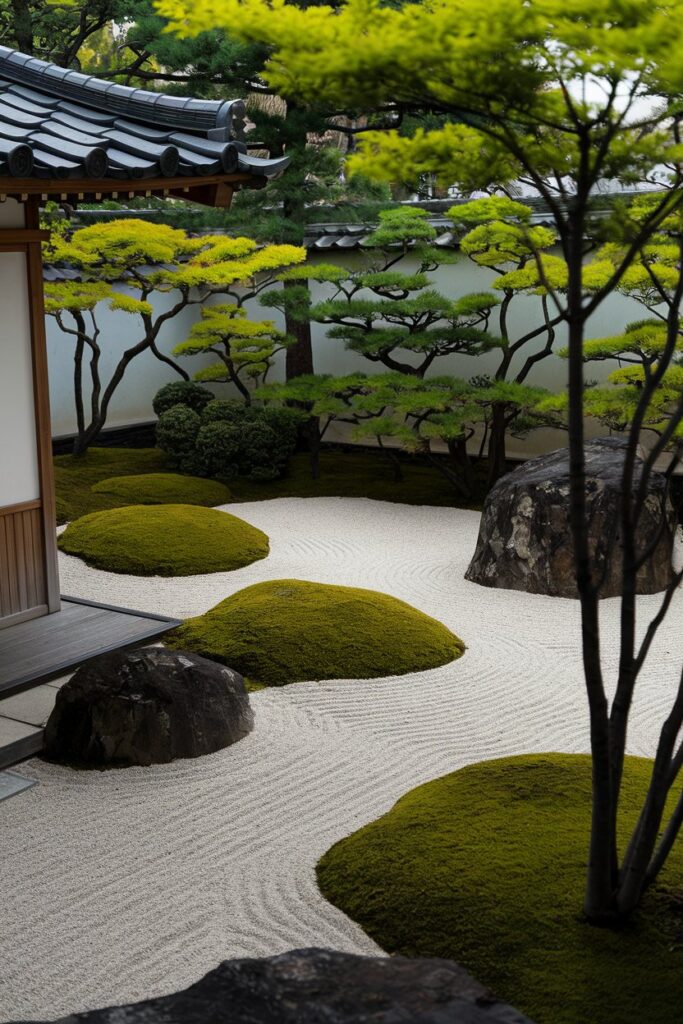
Natural Material Choices for Seating
- Wooden benches or stools made from weathered or reclaimed wood
- Stone or concrete seats that fit right into the garden’s look
- Rattan or woven furniture for a natural, elegant feel
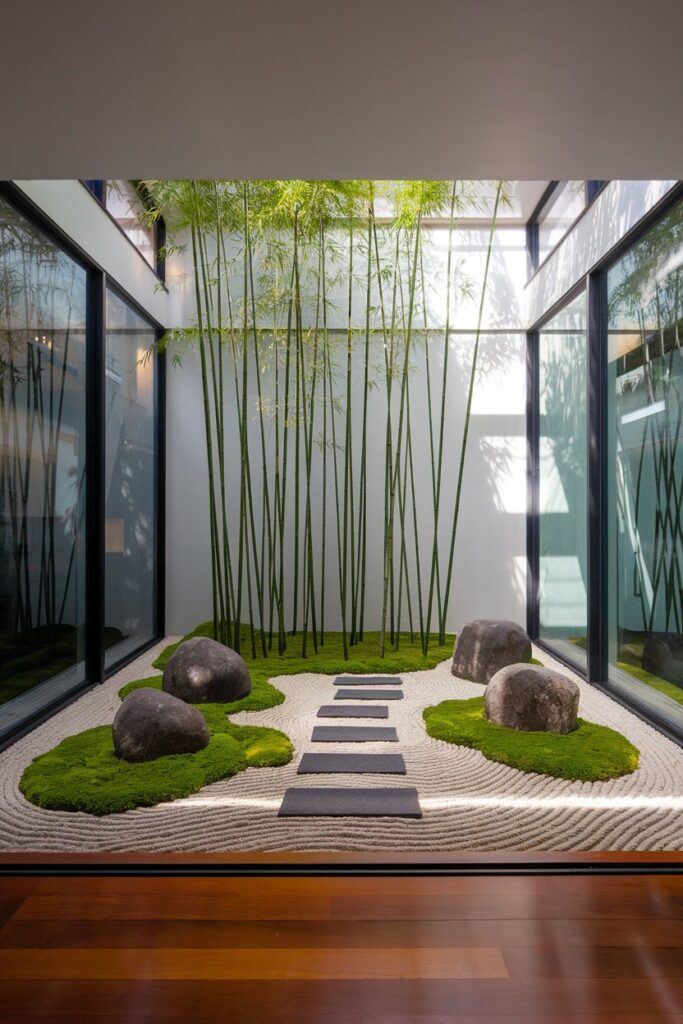
Privacy Screen Options
To make your meditation area more private, think about using natural privacy screens. You could use bamboo fencing, tall ornamental grasses, or selected shrubs and trees. These not only give you privacy but also add to your Zen garden’s beauty.
“The ultimate aim of the art of Zen is to achieve a state of communion with the very source of our being.”
– D.T. Suzuki
Lighting Design for Your Zen Garden
Creating a perfect Zen garden is more than just plants, rocks, and water. Adding Zen garden lighting is key to making your outdoor space a peaceful retreat at night. It brings out the beauty of your outdoor ambiance and nighttime garden design.
Zen garden lighting should be soft and calming. It should highlight your garden’s natural beauty without being too bright. Use low-voltage pathway lights, uplights for key features, and downlights for a gentle glow.
- Choose warm, dimmable lights for a calming effect.
- Use directional lighting to focus on special features.
- Add motion-activated lights for a magical touch.
Remember, less is more in Zen garden lighting. A single, well-placed light can be more powerful than many bright ones. This approach creates a peaceful space for reflection and relaxation.
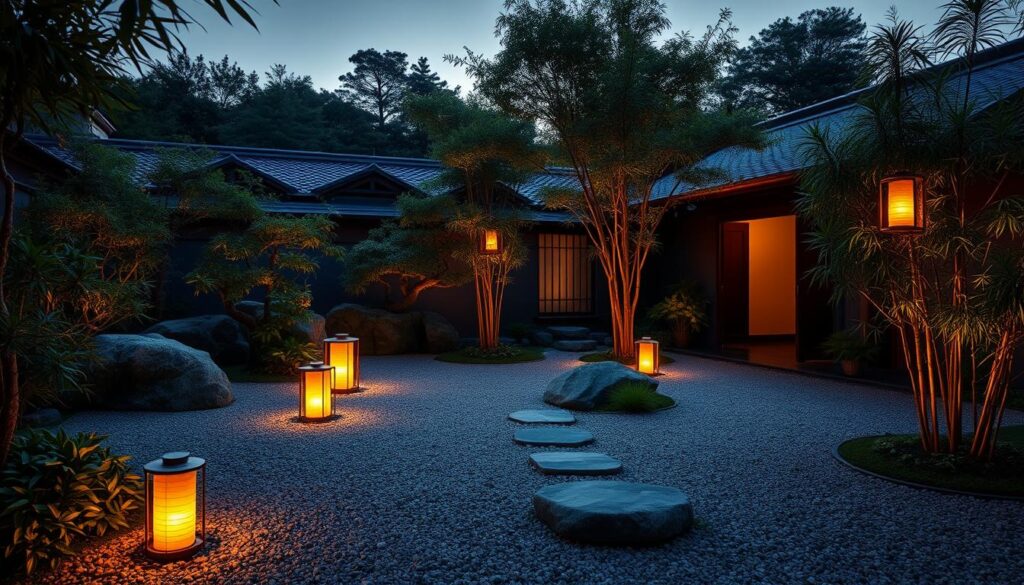
| Lighting Fixture | Purpose | Recommended Placement |
|---|---|---|
| Path Lighting | Gentle illumination for walkways | Along garden paths, at entrances |
| Uplighting | Accentuate focal points and architectural elements | Directed at trees, sculptures, or water features |
| Downlighting | Create a soft, ambient glow | Mounted on trees or structures above seating areas |
“The true essence of a Zen garden is found in its ability to transport the mind to a state of calm and contemplation. Thoughtful lighting design plays a vital role in this transformative experience.”
Conclusion
Creating a Zen garden in your backyard can change your outdoor space into a peaceful haven. By using Japanese garden design, you can make a Zen garden. It becomes a place to relax and find calm.
A Zen garden offers many benefits. It’s a place to connect with nature and find balance. You can enjoy its calming sights and sounds, no matter the size of your space.
We invite you to start your Zen garden journey. With the right design and plants, your backyard can become a peaceful retreat. Enjoy the beauty and calm of your Zen garden and see how it improves your life.
FAQ
What is a Zen garden and how can it transform my backyard?
A Zen garden is a Japanese-inspired outdoor space. It promotes relaxation and a deep connection with nature. By creating one in your backyard, you can turn it into a peaceful sanctuary. Here, you can find relief from daily life stresses.
What are the key elements of traditional Zen garden design?
A Zen garden includes carefully selected rocks, gravel, and minimalist plants. These elements are arranged to reflect simplicity, balance, and harmony. These are key principles of Japanese garden aesthetics.
How do I choose the right materials for my Zen garden?
Choose natural, high-quality materials for your Zen garden. Look for rocks, gravel, and drought-tolerant plants that fit your local climate. These should also complement your garden’s design.
What are some tips for arranging the rocks and gravel in my Zen garden?
Arranging rocks and gravel in your Zen garden is an art. Experiment with patterns and techniques. Rake the gravel to create movement. Place rocks to enhance visual flow and balance.
How can I incorporate water features into my Zen garden design?
Water features like small ponds, fountains, and waterfalls add tranquility. They provide a soothing sound and enhance harmony in your space.
How can I create a Zen garden in a small outdoor area?
You can create a Zen garden even in a small space. Use compact designs and focus on key elements. Choose carefully selected rocks, gravel, and low-maintenance plants to maximize serenity.
What types of plants work best in a Zen garden?
Choose plants that reflect simplicity and elegance. Japanese maples, bamboo, ornamental grasses, and bonsai trees are great options. They add natural beauty and balance to your space.
How can I incorporate meditation areas and seating into my Zen garden?
Provide comfortable seating areas in your Zen garden. This invites visitors to pause and reflect. Use natural materials and privacy screens to enhance the meditative experience.
How can I use lighting to enhance the ambiance of my Zen garden at night?
Use subtle, low-level lighting to highlight your Zen garden at night. Choose lighting that shows off water elements or sculptural rocks without overpowering the space.
